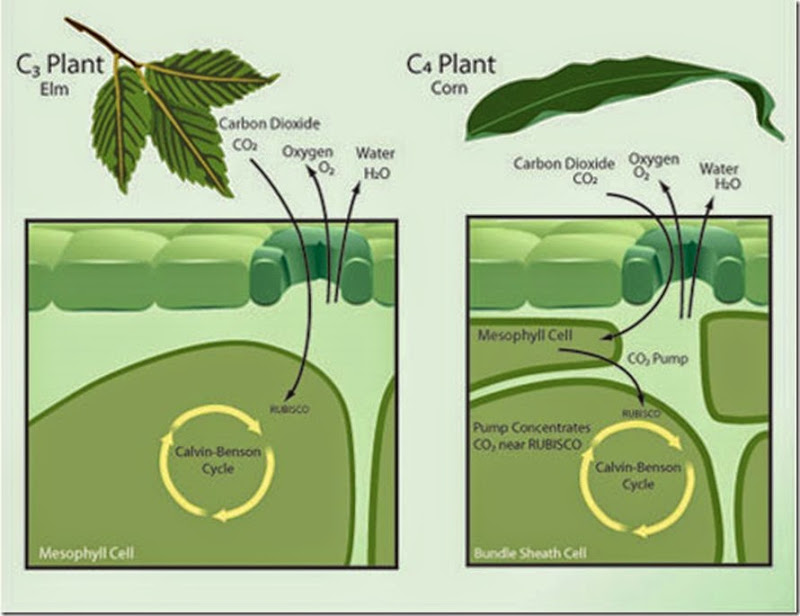The difference between C3 and C4 plants
Photosynthesis is the process that plants use to turn light, carbon dioxide, and water into sugars that fuel plant growth, using the primary photosynthetic enzyme Rubisco.
The majority of plant species on Earth uses C3 photosynthesis, in which the first carbon compound produced contains three carbon atoms. In this process, carbon dioxide enters a plant through its stomata (microscopic pores on plant leaves), where amidst a series of complex reactions, the enzyme Rubisco fixes carbon into sugar through the Calvin-Benson cycle. However, two key restrictions slow down photosynthesis.
- Rubisco aims to fix carbon dioxide, but can also fix oxygen molecules, which creates a toxic two-carbon compound. Rubisco fixes oxygen about 20 percent of the time, initiating a process called photorespiration that recycles the toxic compound. Photorespiration costs the plant energy it could have used to photosynthesize.
- When stomata are open to let carbon dioxide in, they also let water vapor out, leaving C3 plants at a disadvantage in drought and high-temperature environments.
However, plants have evolved another form of photosynthesis to help reduce these losses in hot, dry environments. In C4 photosynthesis, where a four-carbon compound is produced, unique leaf anatomy allows carbon dioxide to concentrate in 'bundle sheath' cells around Rubisco. This structure delivers carbon dioxide straight to Rubisco, effectively removing its contact with oxygen and the need for photorespiration. What's more, this adaptation allows plants to retain water through the ability to continue fixing carbon while stomata are closed.
C4 plants—including maize, sugarcane, and sorghum—avoid photorespiration by using another enzyme called PEP during the first step of carbon fixation. This step takes place in the mesophyll cells that are located close to the stomata where carbon dioxide and oxygen enter the plant. PEP is more attracted to carbon dioxide molecules and is, therefore, much less likely to react with oxygen molecules. PEP fixes carbon dioxide into a four-carbon molecule, called malate, that is transported to the deeper bundle sheath cells that contain Rubisco. The malate is then broken down into a compound that is recycled back into PEP and carbon dioxide that Rubisco fixes into sugars—without having to deal with the oxygen molecules that are abundant in the mesophyll cells.

C3 plants do not have the anatomic structure (no bundle sheath cells) nor the abundance of PEP carboxylase to avoid photorespiration like C4 plants. One focus of the RIPE project is to create a more efficient pathway for photorespiration to improve the productivity of C3 crops.
The RIPE project is also working to improve photosynthesis in C3 crops to ensure greater food security under future climate scenarios. C3 plants are limited by carbon dioxide and may benefit from increasing levels of atmospheric carbon dioxide resulting from the climate crisis. However, this benefit may be offset by a simultaneous increase in temperature that may cause stomatal stress.
C3 plants include some of the most important sources of calories all over the world: cowpea, cassava, soybean, and rice. The regions where these crops are grown in are often hot and dry, meaning they could benefit from the energy-saving mechanisms of C4 photosynthesis. While C3 photosynthesis has more room for improvement, our computer models suggest that we can improve both types of photosynthesis to increase crop production.
By: Katherine Meacham-Hensold || Edited by: Amanda Nguyen
